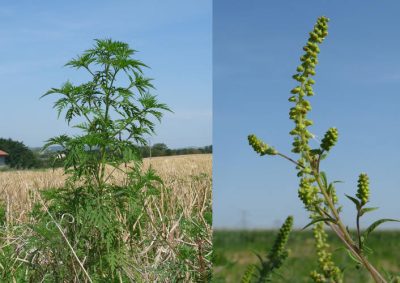当入侵植物也在田间扎根

公众很容易察觉生物入侵,人们能发现路边、池塘或城市荒地中外来动植物种群的发展。如果生物入侵不是物种消失,或至少不是动植物多样性急剧减少的原因之一,那么在全球多样性减少的背景下,这些物种的扩张动态可能还令人满意。入侵植物问题涉及所有的环境,尤其是农业环境。实际上,农业既是许多物种引入的原因(有意或无意),也是主要受害者之一。入侵物种导致减产,农民使用的除草剂增多,这就是一个环境问题。此外,一些物种,例如豚草,能导致人类严重过敏。似乎只有预防管理才能在一定程度上提高效率并控制入侵物种数量,使其能融入当地植物群。法国已经建立了流行病学监测网络来预测此类生物入侵。
1. 移动的植物
20世纪初以来,亚洲虎蚊、亚洲大黄蜂、佛罗里达海龟、河狸鼠、豚草甚至灵长类动物,我们所面临的增殖物种数量一直稳步增长。当这些物种被人类(有意或无意)引入远离其自然分布范围的地区,且其传播威胁到生物多样性、经济以及/或者人类健康时,则被称为“入侵物种”。
法国目前记录在案的6000种维管植物中,超过20%被认为是非本地物种,但仅有百余种具有迅速扩繁行为,至少在当地是如此。许多法规都试图约束或组织对抗这些物种的扩张。最新的欧洲法规1143/2014号[1]制定了入侵物种引入和扩散管理规则,以防止、尽量减少和减轻这些物种在欧盟的引入和传播及其对生物多样性的不利影响。

快速、大规模的植物入侵(图1A)可能是危害根源,控制措施(化学除草、割草、拔草)往往成本高昂。尽管有时成本很高,但结果往往不尽如人意(图1B),还会对环境产生显著负面影响。除草行为(合成除草剂、密集割草、湿地清理)会对社区原本脆弱的生态环境产生负面影响。这些影响有时会直接影响到人类自身,例如布列塔尼海岸的绿潮(石莼,Ulva lactuca)[2](参见环境中的硝酸盐以及磷和富营养化)。
20世纪50年代末以来,生态学界开展了众多理论和实践工作,研究植物生长范围变化,以便更好理解这些现象。这些研究涉及从健康到生态学等不同学科的研究人员。气候变化会加速一些植物的入侵进程,为更好预测其潜在入侵和未来扩张,人们对气候变化影响进行了广泛的研究和建模。
2. 物种越多麻烦也越多
生物入侵相关的主要问题之一是当地植物多样性下降[3]。许多研究关注入侵植物对脆弱生态环境的负面影响,在这种环境中,本地物种可能遭遇竞争能力更强或有化感作用(向其他植物释放有毒化合物)的入侵物种的威胁。其他入侵物种也能改变初始环境:过度消耗水分、改变有机物降解。因为土壤特征变化,最初的植物群落难以重建,因此这些转化物种使得环境难以恢复[4]。
生物入侵现象与贸易全球化紧密相关。专家们将发现新大陆(15世纪末)作为植物新引入潮的关键时期,例如如今田间十分常见的苋属植物。出于审美的有意引入的植物,如大叶醉鱼草(Buddleja davidii Franch.),或在植物园中栽培的植物,如飞蓬属植物(Erigeron),其中一些物种已融入常见植物群,如阿拉伯婆婆纳(Veronica persica Poir.)。
随着现代交通工具和全球化的发展,新植物物种在整个19世纪和20世纪加速到来。港口、车站、道路、砾石坑或棕地等人类化以及受干扰环境是外来入侵植物的栖息地。尽管从生态学角度来看这些环境似乎特别“艰难”(土壤或多或少人工化、营养贫瘠,或因水资源有限、用水压力加剧导致的土壤污染),入侵植物常定居这些环境的理由有两点:
- 这些人类栖息地的商品引入频率很高,理论上来说,随商品意外引入的个体找到合适定居条件的机会相应增加。
- 来自植物的竞争强度低,这里的植物不构成足够密集、重要和稳定的群落,无法阻止新物种发展。
因此,与人类活动相关的栖息地退化会削弱当地动植物群落,促进入侵植物的发展。
3. 为何在田间?
外来入侵植物也会影响栽培环境[5],这些环境因施加的选择压力而构成独特的生态系统。
3.1. 有利的耕作措施
农民们采取的各种耕作方法包括:
- 耕耘和机械除草带来的环境干扰;
- 化学或热除草法;
- 优先以最佳密度播种作物,以提高产量。
这些措施形成了仅有有限数量物种能够存活的环境。因此,选择压力既强烈又频繁,但由于作物轮作,选择压力在时间和空间上又存在很大差异。

能够忍受甚至受益于这些耕作方式的物种将拥有一个几乎没有可使用景观结构、营养富集的广阔区域,这非常适合入侵生物的发展。这些生物可能是偶然闯入耕作地块(小麦田里的虎杖(Reynoutria japonica),图2)。但是需要农民采取化学或机械除草干预,以避免这些物种持续“安扎”。如果入侵物种将害虫带到作物中,且害虫因物种而异,则会导致减产,甚至作物完全毁坏。
在发展初期,一年生作物只覆盖小部分土地,使得耕作区的自然植被(通常称为杂草或杂草群)得以发展。为弥补这种低覆盖能力,农民会在作物出苗时使用除草剂进行化学除草,或通过早期机械除草,亦或在行间种植活或死的植被覆盖物。
然而,这些方法不足以限制杂草群落。入侵物种通常拥有极强的发育能力,这与多种因素有关:独特的生物学特性、除草措施的低效性、缺少捕食者或寄生虫的生物控制。据观察,春、夏季作物比冬季作物含有更多的入侵物种。这一现象可以用入侵物种的生物学特性解释:许多外来物种(苍耳、苋菜等)都来自不同大陆(亚洲、非洲、美洲),属于夏季植物,特别适合生长在玉米等作物周围。然而,如果该物种没遇到有利的生态环境,其发展也会受到限制,正如当前入侵法国的苘麻(Abutilon theophrasti),其原产于亚洲[6]。
3.2. 独特的生物学特性

- 其中一些物种似乎经常出现体型庞大(争夺光照)、植株生长旺盛、开花早且花期长等特点。
- 入侵物种会产生大量种子,一株豚草就能产生超过1000粒种子。这不足以将其与其他杂草区分,因为其他杂草能产生更多种子(每株虞美人(Papaver rhoeas)能产生超过 20,000粒种子)。 但入侵物种的特点是种子在土壤中的存活时间长(图3),这使它们能积累大量种子,存活期长达 10 年。
入侵植物在农作物中的成功部分源于其占据了空缺的生态位[7],因为欧洲本地物种主要是冬季萌发的物种。此外,通过比较美洲物种在农作物中的出现频率,这些入侵物种中只有3% 存在于冬季谷物中,27% 存在于夏季作物(玉米或高粱)中,而葡萄藤和果园中则有约50%。因此,这些物种定植于栽培环境主要是因为占领植物竞争低的环境,而不是生物入侵造成多样性丧失这一风险。 然而,对于农民来说,这是一个新问题,有时也是一个需要管理的重要问题。
3.3. 抗除草剂植物
然而,如今在田间看见的一些问题入侵杂草是新石器时期随第一批农作物(所谓的史前杂草)一起引入的植物,如蓝花矢车菊(Cyanus segetum Hill)、麦仙翁(Agrostemma githago L.)。这些植物地理分布范围突然扩大通常是因为耕作方式的变化,而耕作方式的改变迄今一直是致命的选择压力,或因为新环境条件对其特别有利(减少耕作)。上世纪中叶禾本科杂草种群(野燕麦、黑麦草、黑草)的发展得益于第一批除草剂的使用,该除草剂仅消灭阔叶树种。

至少18世纪以来,一年生草本大穗看麦娘(Alopecurus myosuroides Huds.;图4)就被视为潜在杂草,现广泛分布于法国超过三分之一的冬小麦田间(超过200万公顷)。20世纪60年代起,由于能适应短期冬季作物轮作,这种植物成为欧洲种植系统中的主要杂草之一。但是,与其他杂草一样,其成功入侵还得益于具有能抵抗不同除草剂的遗传能力,以至于难以仅靠化学方法控制。

其他具有相似特性的物种如今也在增加,例如雀麦(Bromus sp.)、野燕麦(Avena fatua L.)或鼠茅(Vulpia myuros L.)。在除草剂控制占主导地位的种植系统中,对除草剂的适当耐受可能足以促进老鹳草等高密度植物的生长与发展(图5)。
3.4. 豚草:农业和公共卫生问题
在耕地入侵物种中,豚草(Ambrosia artemisiifolia L.;图6)是最难逃“杂草”之名的植物之一。这种一年生菊科草本原产于北美大陆,是法国强制销毁的高等植物之一[8],也位列黛西(DAISIE)数据库中100种最有问题的物种[9] [10]。

豚草因其高致敏性花粉而闻名[11],对于向日葵和大豆等作物来说,它也是一种极具竞争力的杂草。与其他外来入侵植物不同,豚草在法国的出现和发展有据可查,部分原因是其独特形态不可避免地吸引了植物学家的眼球,还有部分原因是其引入期与法国大型植物标本馆收藏时期重叠,藏品中可以找到丰富信息[12]。19世纪60年代,红车轴草 (Trifolium pratense L.) 的栽培被多次提及,是法国,也是其他相关欧洲国家(德国、荷兰、英国)的进口媒介。
豚草的例子说明对特定的入侵物种,可能存在不同的影响:农业问题、公共卫生问题。由于人类[13]和牲畜[14]食用后存在中毒风险,曼陀罗(Datura stramonium L.;图7)的发展也带来了农业/健康领域的双重问题。
事实上,耕地中的一些入侵物种也会对环境造成潜在威胁:双穗雀稗(Paspalum distichum L.)和刺果瓜(Sicyos angulata L. )降低了河畔森林和湿地的多样性。
某些情况下,种植生态系统可能只在特定物种的引入和扩散阶段发挥重要作用,而最重要的负面影响可能涉及公共卫生问题或路边管理额外成本。
3.5. 作物中需要监测的其他物种
对于没有造成健康问题而鲜为人知的其他物种,也应在作物中密切监测:
- 美洲商陆(Phytolacca americana)于18世纪初引入法国,用于装饰,特别是用其果实给劣质红酒着色。在兰德斯地区,由于松树林被砍伐,土壤种子库中已有美洲商陆,如今松树林空地上种植的玉米作物极具入侵性。
- 虽然莎草科在温带栽培环境中并不常见,但油莎豆(Cyperus esculentus leptostachyus)是一种世界性杂草。该物种于20世纪80年代随美国和荷兰的球茎到达法国西南部和索洛涅,其生长扩散非常迅速,极难控制[15]。
- 最后,来自北美的茄科植物银叶茄(Solanum elaeagnifolium)已成为马格里布地区的可怕杂草,以至于因担心其在法国定殖,法国南部一出现该物种便采取了根除行动[16]。
4. 耕作环境中有待研究的影响
虽然耕地中的入侵植物会导致减产和农业问题,但通常不会直接造成环境问题。事实上,对植物群落采取的栽培手法所施加的选择压力似乎比入侵植物施加的压力更强烈。但依旧需要加强对入侵植物的控制,其可能危害环境和耕地中的其他物种,尤其是那些非常稀有、依赖作物的物种。入侵植物的管理问题与“当地”杂草并无二样,但可能需要额外的除草干预以针对其生物学特性(刈割、使用除草剂)。生物防控在传统杂草中效果很差,可能是有待开发的解决方案,但是它们有着复杂的系统,需要对相关不同物种之间的生物学和生物相互作用有透彻的了解[17]。
目前,气候变化引起的温度和降雨格局的变化可能会加速地中海地区新物种的恢复和建立。许多气候屏障(如秋季早霜消失、春季水分胁迫期)将通过允许特定物种产生种子直接促进入侵植物的生长,或限制本地植物的竞争来间接促进入侵植物的生长。如果没有一般的管理规则,减少人工合成除草剂的使用可能会需要根据每个物种的生物学特性采取预防措施,以防止在土壤中建立大量种子库(会使得管理方法很有限)之前物种的发展。
参考资料及说明
封面照片:豚草(Ambrosia artemisiifolia L.)入侵向日葵田的情形。入侵植物导致部分地区的农作物完全消失。[来源:©阿兰·罗德里格斯摄( Alain Rodriguez)]
[1] https://eur-lex.europa.eu/legal-content/FR/TXT/PDF/?uri=OJ:JOL_2014_317_R_0003&
[2] Merceron M. 1999. Marées vertes en Bretagne : état actuel des connaissances. Colloque ” Pollutions diffuses : du bassin versant au littoral “, Ploufragan, 23-24 September 1999. 49-60. (in french)
[3] Gurevitch J., Padilla D.K. 2004. Are invasive species a major cause of extinctions? Trends in Ecology and Evolution, 19, 470-474.
[4] Conser C., Connor E.F. 2009. Assessing the residual effects of Carpobrotus edulis invasion, implications for restoration. Biological Invasions, 11, 349-358. DOI 10.1007/s10530-008-008-9252-z
[5] Chauvel B., Fried G. 2009. Dans la jungle des milieux cultivés. Dossier Pour la Science, Numéro spécial Invasions Biologiques, 65 – La conquête des espèces, 32-37. (in French)
[6] Chauvel B., Rodriguez A., Fried G. 2017. Focus sur une espèce : Abutilon theophrasti, pas encore la fibre pour s’installer en France ? Journal de Botanique de la Société Botanique de France, 77, 41-48. http://ecophytopic.fr/sites/default/files/JB77-41a48.compressed.pdf (in French)
[7] Mallet, J., Lopez-Garcia, C. 2000. What criteria are relevant for predicting the invasive capacity of a new agricultural weed? The case of invasive species in France. Weed Research, 40, 11-26.
[8] https://www.legifrance.gouv.fr/affichTexte.do?cidTexte=JORFTEXT00000034503018&dateText=&categoryLink=id
[9] http://www.europe-aliens.org/speciesFactsheet.do?speciesId=21692
[10] 在法国,只有少数本地植物得以强行控制,包括大田蜡梅(Cirsium arvense(L)Scop.)、菟丝子(Cuscuta spp.)和欧斑茅(Orobancha ssp.)。
[11] 许多人都对豚草花粉过敏:6% 到 12% 的人口对豚草过敏。 每立方米空气中只需要 5 粒花粉即可导致过敏症状。
[12] Chauvel B., Dessaint F., Cardinal-Legrand C., Bretagnolle F. 2006. The historical spread of Ambrosia artemisiifolia in France from herbarium records. Journal of Biogeography, 33, 665-673.
[13] http://agriculture.gouv.fr/intoxications-alimentaires-liees-la-consommation-de-farine-de-sarrasin
[14] Chamber of Agriculture Lozère, 2013
[15] Bohren C., Wirth J. 2015. La propagation du souchet comestible (Cyperus esculentus) concerne tout le monde. Recherche Agronomique Suisse, 6 (9), 384-391. (in French)
[16] IBMA WG. 2016. Base d’information sur les invasions biologiques en milieux aquatiques. National Working Group on Biological Invasions in Aquatic Environments. IUCN France and Onema. http://www.gt-ibma.eu/espece/solanum-elaeagnifolium/ (in French)
[17] Müller-Schärer H., Lommen S., Rossinelli M., Bonini M., Boriani M., Bosio G., Schaffner U. 2014. Ophraella communa, the ragweed leaf beetle, has successfully landed in Europe: fortunate coincidence or threat? Weed Research, 54, 109-119.
环境百科全书由环境和能源百科全书协会出版 (www.a3e.fr),该协会与格勒诺布尔阿尔卑斯大学和格勒诺布尔INP有合同关系,并由法国科学院赞助。
引用这篇文章: CHAUVEL Bruno (2024年2月23日), 当入侵植物也在田间扎根, 环境百科全书,咨询于 2024年4月26日 [在线ISSN 2555-0950]网址: https://www.encyclopedie-environnement.org/zh/vivant-zh/when-invasive-plants-also-wander-the-fields/.
环境百科全书中的文章是根据知识共享BY-NC-SA许可条款提供的,该许可授权复制的条件是:引用来源,不作商业使用,共享相同的初始条件,并且在每次重复使用或分发时复制知识共享BY-NC-SA许可声明。






